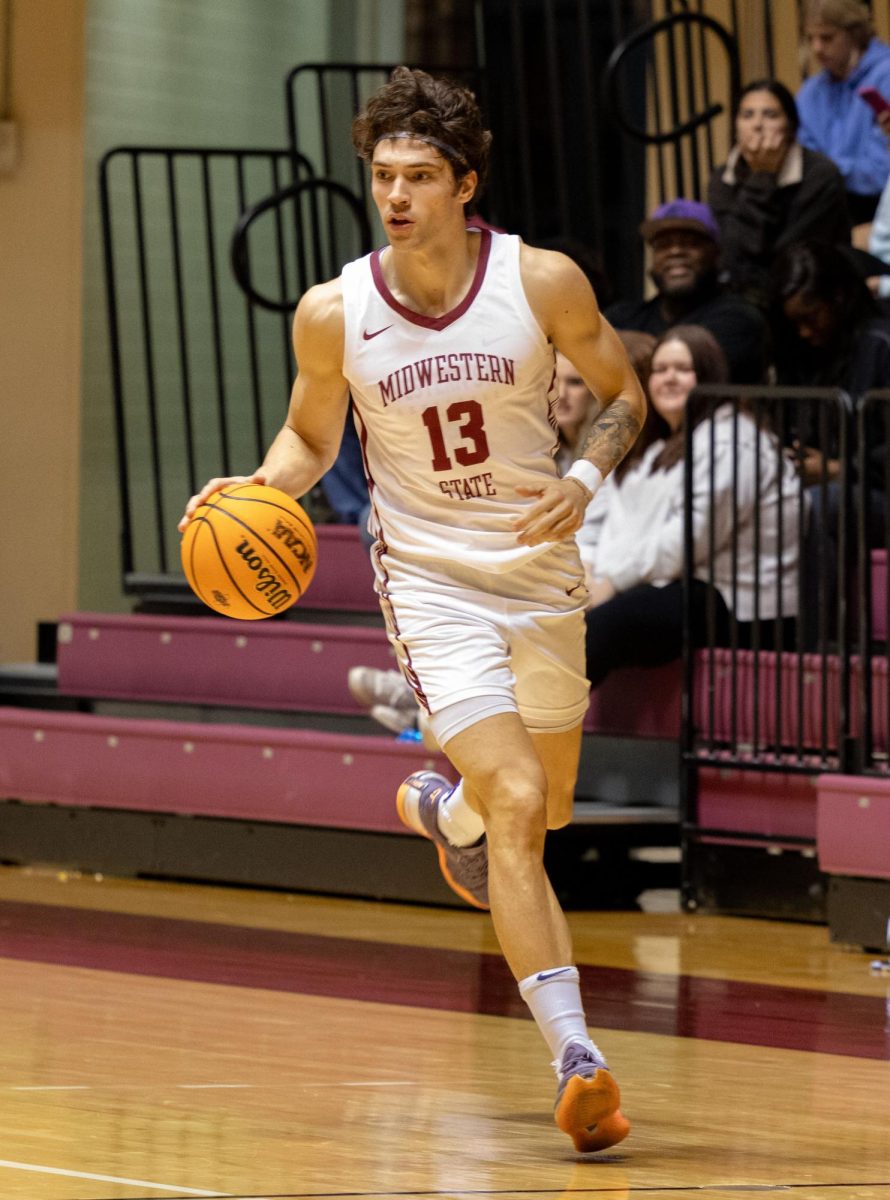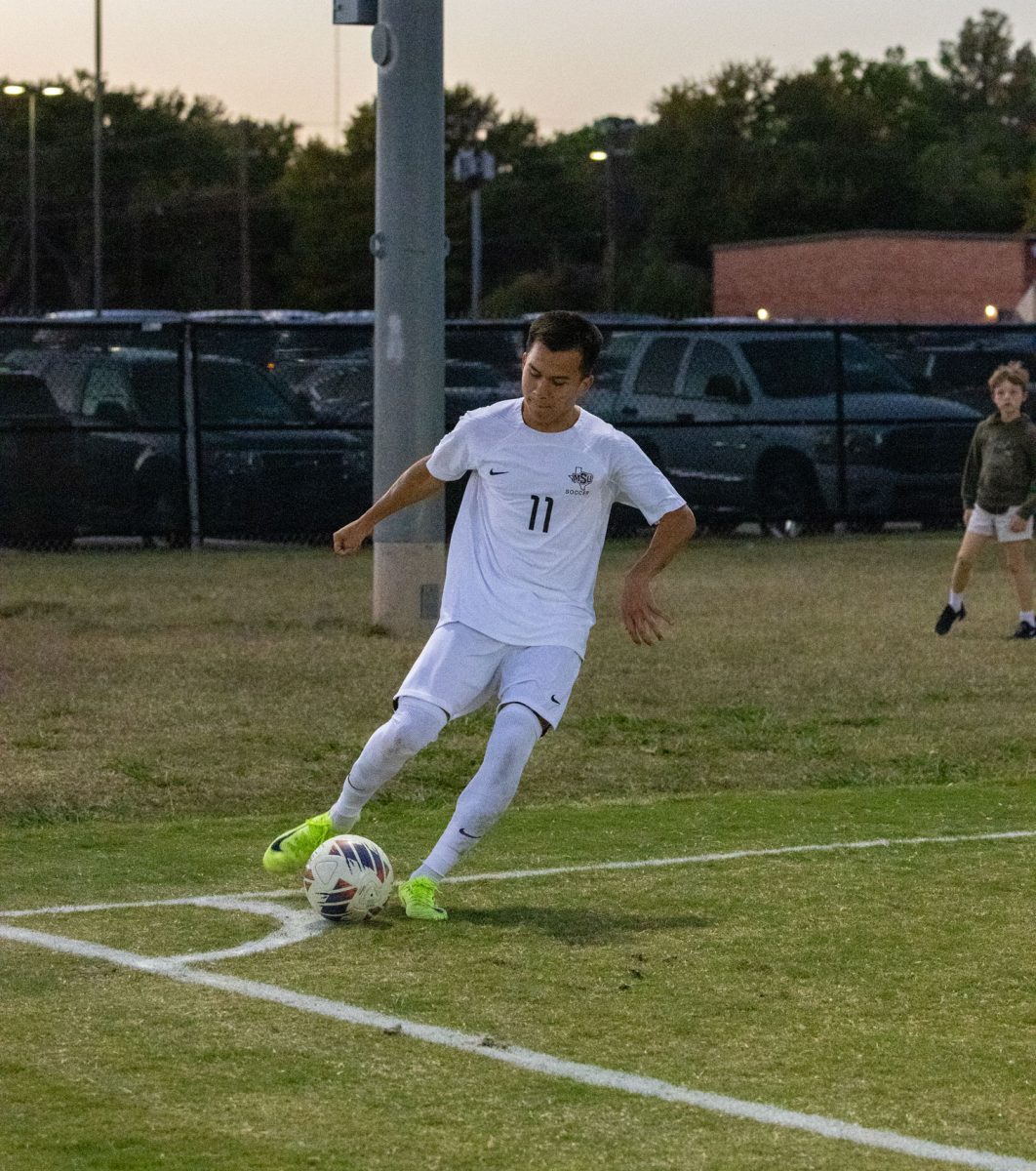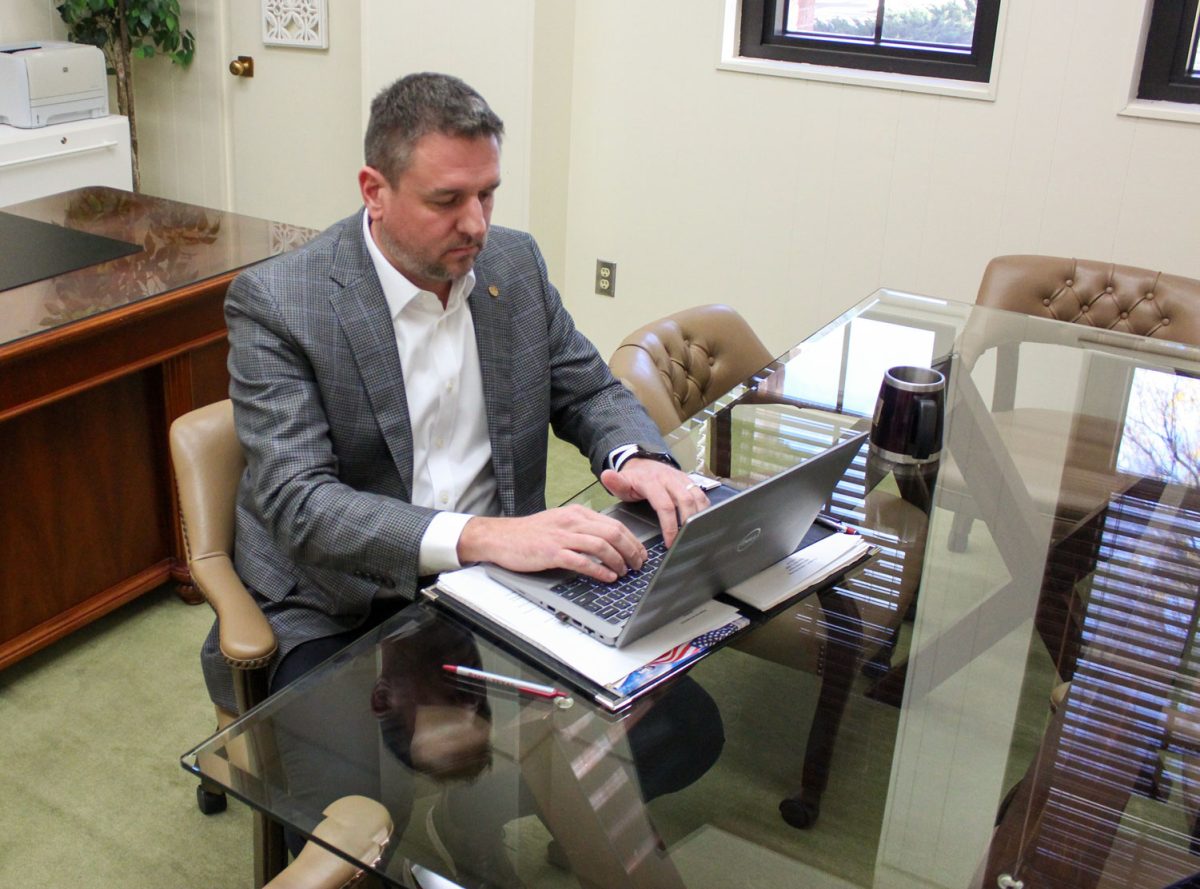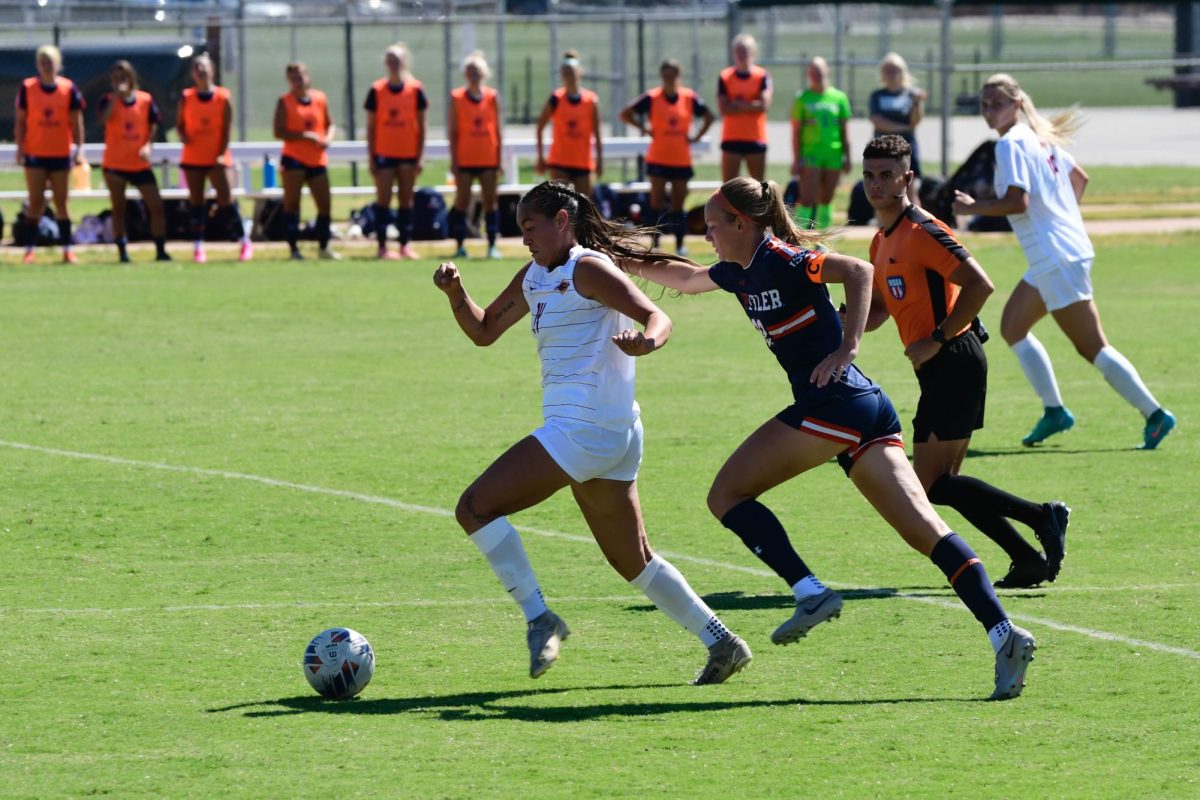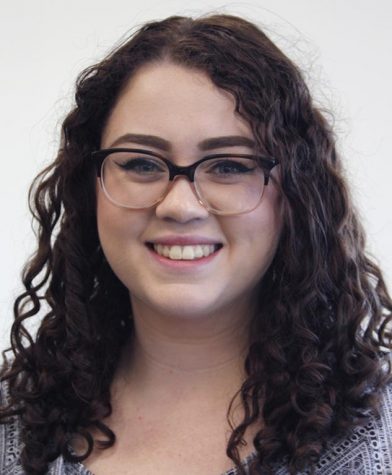 Enrollment increased nearly three percent as 169 more students enrolled at Midwestern State University than last fall, yet not keeping up with growth at other Texas schools. Still, officials say things are finally looking up for Midwestern State University. From 2010 to 2013, total student enrollment dropped by 556 students. In response to this decline, worried officials developed several strategies to reverse the enrollment situation. This year’s increase is a result of aggressive recruiting for larger incoming classes and several programs put in place to maintain student retention, according to Keith Lamb, vice president of student affairs and enrollment management.
Enrollment increased nearly three percent as 169 more students enrolled at Midwestern State University than last fall, yet not keeping up with growth at other Texas schools. Still, officials say things are finally looking up for Midwestern State University. From 2010 to 2013, total student enrollment dropped by 556 students. In response to this decline, worried officials developed several strategies to reverse the enrollment situation. This year’s increase is a result of aggressive recruiting for larger incoming classes and several programs put in place to maintain student retention, according to Keith Lamb, vice president of student affairs and enrollment management.
“We were obviously very pleased with it,” Lamb said. “We budgeted a flat enrollment to be conservative, just in case we were wrong, but we knew at some point it would start growing back.”
Director of Admissions Gayonne Beavers said the admissions office has altered its previous recruitment approach to a more involved, hands-on version, which has resulted in the slight influx of incoming freshmen.
“We have a small admissions staff, so we try to touch as many students’ lives as we can despite our small size. We’re out there doing presentations in classrooms, going to college fairs, having luncheons with advisors at community colleges, etc. We’re doing this with more frequency and more intention than in the past,” Beavers said. “We’re going into high schools more than we have and building relationships with guidance counselors all over the state of Texas to get our name out there, which in turn helps with recruiting.” 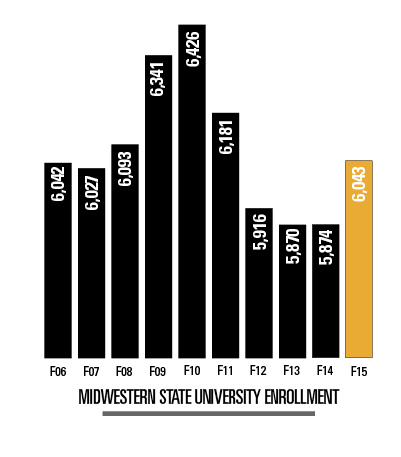
Fall 2015 enrollment officially hit 6,043 students, topping 6,000 for the first time since the fall of 2011. This includes 820 first-time freshmen, 523 transfers, and 114 international students – an increase of 169 total students.
“We are making efforts to continue to recruit those higher ability students with the scholarships that we offer and other things like that, because studies show that the higher ability students that a university has, the better their retention rate usually is,” Beavers said. “It’s kind of a twofold win-win.”
In addition to an increase in overall student enrollment, the university is also seeing an increase in the quality of students.
“This year, preliminary data suggests their average SAT (scores) increased 10 points,” Lamb said, “It looks like a few more students were in the top quarter of their high school class.”
And there are fewer students who go on probation or academic suspension, according to Lamb. Another area of growth is the graduate school, seeing a record 683 students enrolled this semester.
Growth basically flat
Last year, Lamb said, the university saw a growth of four students in total. While this was considered flat enrollment, the news provided a light at the end of the enrollment tunnel: the decline had ceased.
“That was essentially the flattening-out of enrollment, and we knew that would happen at some point, and that’s when we stopped the decline and now you’re starting to see the building back,” Lamb said.
The aggressive recruiting aspect of the reversal strategy had the most impact on increasing enrollment. One aspect of the university’s aggressive recruitment efforts was the assignment of an admissions counselor to transfer recruitment.
“I think that was the lever we pulled that had the most impact on this year’s increase in transfer students,” Lamb said.
This year saw the enrollment of 523 transfer students – an increase of almost 70 students from fall 2014. This is one of the biggest factors Lamb attributes to the increase in enrollment.
Aggressive recruitment
Another aspect of the aggressive recruitment was hiring an assistant director for admissions stationed in Dallas.
“What we see is a plurality of our students are coming from DFW,” Lamb said.
Both Lamb and Beavers added that they plan on assembling a recruiting team in Dallas, knowing that is where most MSU students come from.
“A large portion of the current student body is from the Dallas area, almost 30 percent actually. It’s a bread-and-butter area for Midwestern,” Beavers said. “The issue we’ve faced in the past is that we are a couple of hours north of the metroplex, so we can’t get down there as often as we should. That’s why we’re hiring someone to recruit solely in the DFW metroplex, in addition with the recruiter in the Austin and Waco area.”
Residential life also plays a big part in enrollment.
“We have become a destination school,” Lamb said, “And with that is a certain level of affection that does help with retention.”
With the increase in students coming from DFW and Austin, the university has been preparing for a more robust on-campus experience. The most obvious preparation is the new dorm.
“We would have come close to filling it this year if it was open,” Lamb said, “We should be pretty full next year.”
While one half of increasing enrollment is recruiting new students, the other half is retaining existing students. According to Lamb, the most accurate way to measure student retention is by monitoring the freshman class.
“Really what we look at is freshman fall to fall,” Lamb said, “Do they come back for their sophomore year?”
According to Lamb, the national average of student retention hovers around 70 percent. 72 percent of freshmen from 2013 returned in the fall of 2014. Likewise, 70 percent of fall 2014 freshmen returned in the fall of 2015.
“We think there’s a big opportunity for improvement,” Lamb said, “I think there are some things we can do on campus that we’re working on and focused on where we can improve that retention rate.”
Lamb added that they are working on increasing tutoring opportunities for students to help them be more successful in the classroom.
“If we help students with academic self-efficacy through tutoring and other types of programs,” he said, “That will go a long way toward retention.”
Five new lecturer positions were filled this fall to produce enough courses for the additional students.
“From the academic side, we have to make sure we have enough classes and enough professors to teach those classes. We don’t want students coming to the campus, expecting to take a certain class, and then we don’t have a section for them,” Provost Betty Stewart said. “This isn’t so much of a challenge as it is an opportunity, because that means the university is growing, which is always a positive thing.”
Freshman seminar
The biggest project they are working on, however, is a mandatory freshmen seminar. The university has an optional freshmen seminar in place, but Lamb believes a mandatory course would greatly improve student retention and the overall campus experience of first-year students.
“A lot of schools do that for a lot of reasons,” Lamb said, “It is a very well-proven retention technique.”
Robert Clark, vice president of administration and institutional effectiveness, is heading up the task force for designing a mandatory freshmen seminar course. The task force includes several faculty staff members and three students. The freshman seminar course is the result of an initiative from 2005 and 2006.
“We went through what is called the first-year experience with the Gardner Institute,” Clark said, “And out of that came a number of recommendations for us. One or two of those we’ve been able to bring to fruition.”
During the year-long process of observing the first-year program at the John N. Gardner Institute for Excellence in Undergraduate Education, several task forces and student success committees came forward but did not last. The program, Clark said, did not receive much institutional support at first. But in 2014 the final task force, of which Clark is the chair, had their first meeting to begin the process of developing a mandatory freshman seminar course.
“The freshman seminar is part of an overall freshman experience,” he said, “But it’s designed to connect students to the campus culture and to the campus specifically in terms of being able to connect with faculty (and staff).”
Many universities across the country have developed and implemented similar freshman seminar courses. Clark and team looked at the first-year programs at all of the COPLAC schools and several schools in the state of Texas to draw from successful models. He also sent three individuals to a first-year workshop in Atlanta in July.
“We ended up as a task force looking at over 50 institutions,” he said.
One problem Clark and team have run into with developing this program is the Texas legislature in place. The state of Texas, he said, requires 120 credit hours for students to graduate, and the task force is having difficulties deciding how to fit a mandatory freshman seminar course into the already-existing degree programs.
“We have a lot of work,” he said, “We are on a timeline. But it’s something that a lot of schools have embraced across the country and it really creates a way to connect students to the campus.”
Clark said the biggest difference between College Connections, the optional freshman seminar course, and the new model, aside from being required, will be the involvement of faculty.
“Part of it is letting a faculty member just pick something they want to teach,” he said, “It may be outside their realm, but they’re involved in it on a personal level, so you have people teaching Harry Potter and those sorts of things.”
The freshman seminar course will be a conglomeration of efforts by faculty, staff, and students to create a more successful environment for first-year students.
Retention
Another cog in the student retention machine is a program called MAP-Works. MAP is an acronym that stands for making achievement possible, and the program comes from a company called Skyfactor, formerly known as EBI. MAP-Works is a program that collects key demographic information about students, such as where they are from and whether or not they are first-generation students. It also surveys students to gauge their success.
“(The students’) responses to the transition survey go through the system,” said Matthew Park, associate vice president of student affairs and enrollment management. “They go through an algorithm – this is the ‘special sauce’ of Skyfactor.”
Once the program has the necessary information, it then generates a profile for each student and gives administrators a chance to reach out to students before they fail, quit school, or transfer to another university. It allows them to see where students are doing well, where they are struggling, and how the university can intervene or support those students better, according to Park. MAP-Works measures a range of difficulties students may encounter from social woes to academic stress to financial hardships. Getting ahead of these unique needs, Park said, helps increase student retention and gives students a better campus experience overall.
“It helps us align our services, our support, our programming with what the students need most,” he said.
The problem with MAP-Works, as noted by both Park and Lamb, is that only about 65 percent, or two-thirds of first-year students participate in the transition survey.
“If the student does not complete the survey,” Park said, “Then there’s a big piece of the puzzle that’s not in the system.”
Professors and faculty across campus try to encourage students to complete the survey by offering incentives such as extra credit or bookstore scholarships. Park noted that as a university, they try to focus on the students who complete the survey and provide the information needed to make the system successful. The MAP-Works program costs approximately $25,000 a year to run, according to Park.
“The ultimate goal is the successful education of our student population,” Park said.
Additional reporting by Bryson Petersen







